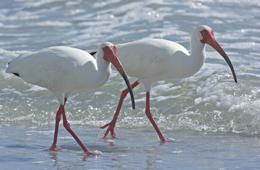TOP STORIES
Does a White Nose Belie a Wing Load of Problems? More on WNS
. . . In a new opinion paper published in BMC Biology, Cryan and colleagues put forth several hypotheses about how infection with G. destructans could cause the mortality observed in the North American bat populations.
Although, to the casual observer, the most obvious manifestation of WNS is the characteristic white fungal growth on the muzzle from which the syndrome derives its name, the real damage to the bats may actually result from what the G. destructans infection does to the wing.
Bats have significantly more exposed skin membrane along their “wings” (stretching from their digits, along their arms to the tail) than on other parts of their body. Because of this, the skin membrane of the wings plays an important role in maintaining homeostatsis.
Promega Connections - promega.wordpress.com
M Arduengo
29 Nov 2010
Photo courtesy of the U.S. Geological Survey
Journal Article Cited
Related News
>>> Bat Genocide [includes photo gallery]
More species means less disease
Biodiversity protects ecosystems against infectious diseases, researchers have concluded.
The finding suggests that loss of species from an environment could have dangerous consequences for the spread and incidence of infections, including those that affect humans.
Felicia Keesing, a biologist at Bard College in Annandale, New York, and her colleagues reviewed several dozen studies published in the past five years and found that the link holds true across various ecosystems, pathogens and hosts.
Nature News - www.nature.com/news
N Gilbert
1 Dec 2010
Photo credit: Visuals Unlimited/naturepl.com
Journal Article Cited
GAO: US needs better program to keep animal diseases out
The safeguards designed to keep diseased animals from being imported into the United States have sizable holes, and the federal agencies that oversee those safeguards need to coordinate better to improve them, says a new report from the Government Accountability Office (GAO).
. . . To study the system for preventing importation of animal diseases, the GAO conducted surveys of animal health experts, interviewed agency officials, and examined the scientific literature. The general conclusion was that the laws and regulations governing live-animal imports have "gaps that could allow the introduction and spread of zoonotic diseases and diseases affecting wildlife," the GAO says.
"In particular, while APHIS has regulations in place to protect agricultural animals from the risk of diseases in live animal imports, CDC does not fully use its statutory authority to prevent the importation of live animals that may pose a risk of zoonotic diseases, and FWS does not generally restrict the entry of imported wildlife that may pose disease risks," the report states.
CIDRAP - www.cidrap.umn.edu
R Roos
09 Nov 2010
Link to Full GAO Report
Mercury causes homosexuality in male ibises
Exposure to mercury pollution could be hitting some wild birds' reproductive prospects hard by causing males to pair with other males.
American white ibises (Eudocimus albus) from south Florida that consumed methylmercury (MeHg), the most toxic and easily absorbed form of mercury found in the environment, were more likely to engage in same-sex pairings — a phenomenon unknown in wild populations of this species with no exposure to the pollutant.
The main sources of mercury globally are coal-fired power plants and gold mining though in Florida, mercury was likely to have been released by the burning of medical and municipal waste.
Nature News - www.nature.com/news
J Milton
1 Dec 2010
Photo credit: W Wisniewski/Minden Pictures/FLPA
Journal Article Cited
Coral reefs found damaged
Up to 90% of coral reefs off the Phi Phi islands has been damaged by bleaching and human activities, a study has found.
The latest survey by the Phuket Marine Biological Centre found the reefs, particularly those around popular diving sites off Phi Phi Don, Phi Phi Lae, Koh Pai, Koh Yung , Koh Bita Nai and Koh Bita Nok, had been damaged and many of them had died, a marine biologist at the centre said.
Malinee Thongtham said a major contributor to the damage was the coral bleaching caused by unusual high sea temperatures during the hot season.
Bangkok Post - www.bangkokpost.com
30 Nov 2010
Location: Phi Phi Islands, Krabi, Thailand - Map It 

OTHER WILDLIFE HEALTH RELATED NEWS
Photo credit: L Madin/AFP/Getty Images- Wildlife trade brings tarantulas, pythons, cobras: Concerns expressed about threats to human health, native wildlife [USA]
- Disease detectives: Bozeman lab on the front lines of wildlife disease research in Montana
- New Report Puts Economic Impact of Feral Cat Predation on Birds at $17 Billion [USA]
- Emergence of African Swine Fever Virus, Northwestern Iran [journal article]
- Scientists find new marine species in waters off Tawi-Tawi Province [Philippines]
- The week in wildlife [image gallery]

- Oceans where fish choke
- Professor Says Stream Fish Imperiled [southeastern United States]







